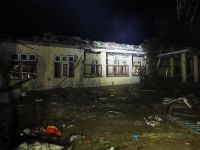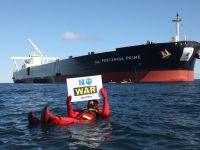Natural Gas:
Israel hopes to increase the share of natural gas in its fuel mix (especially for electricity generation, currently dominated by coal-fired plants) for energy security, economic, and environmental reasons, and has been looking at various options in recent years.
One possibility is gas imports from Egypt's Nile Delta region, either overland across the Sinai peninsula, or via underwater pipeline to the Israeli coast.
Another strong possibility, which has arisen only in the past year or so, is using Israel's own, newly-discovered offshore gas resources.
As far as Egyptian gas is concerned, much depends on regional politics, but ENI, a major gas producer in Egypt, is nearly through construction on a $150-million gas pipeline from offshore fields north of Port Said, Egypt through the Sinai to El-Arish, near the border with the Gaza Strip, and only about 30 miles from Israel.
Using Egyptian gas for power generation in the Palestinian Authority reportedly would cost 3.5 cents per kilowatt-hour, about half the price charged by the IEC. Currently, Gaza is almost totally dependent on the IEC for its electricity needs.
Over the past year, in an important discovery for a country which has never had significant domestic energy resources, several energy companies (Israel's Yam Thetis group, Isramco, BG -- formerly British Gas, and U.S.-based Samedan) have discovered significant amounts of natural gas off the coast of Israel (and the Gaza Strip as well).
Israel's petroleum commissioner, Yehezkel Druckman, estimates 3-5 trillion cubic feet (Tcf) in proven reserves, enough potentially to supply Israeli demand for years, even without gas imports.
In fact, there are signs that the Israeli government may be backing off Egyptian gas imports in favor of its own gas supplies (although Egyptian gas, at least as part of the supply mix, has not been ruled out).
Yam Thetis, for one, appears to be lobbying against Egyptian gas.
Further complicating matters, gas has been discovered not only on Israel's side of the border, but also in areas that appear to straddle Palestinian and Israeli waters, as well as in areas that appear to lie in Palestinian territory.
Israel's new offshore gas reserves belong mainly to two groups: 1) the Yam Thetis group, which includes Israel's Delek Drilling and Avner Oil; as well as Samedan and Reading & Bates; and 2) a BG partnership with Isramco and others. In August, Isramco announced that it had discovered a large gas field 12 miles offshore at its Nir-1 well.
The field reportedly contains gas worth more than $1 billion, and represents the third gas field discovered offshore Israel during 2000.
Palestinian offshore gas is being developed by BG. Several groups reportedly are competing to supply gas to the IEC, including Yam Thetis and BG/Isramco, plus local group Sdot Yam and the East Mediterranean Gas joint venture (between Merhav, Egyptian General Petroleum Corp., and Egyptian businessman Hussain Salem).
In October 1999, BG had bought 50 percent of Isramco's drilling rights. In early November 1999, BG, Isramco, and four other Israeli partners began drilling for gas at the offshore Or South site, near another well (Or-1) in the Med Yavne concession where gas was discovered (by BG) a week earlier and which tested at 21 million cubic feet per day of high-quality dry gas.
Samedan (which in October 2000 reportedly purchased half of Mediterranean Ltd.'s share of the offshore Israel gas territory) has stated that its Noa offshore gas field could contain as much as 330 Bcf of natural gas.
In a related development, in late December 1999, Dow Jones reported that Israeli officials would not challenge Palestinian plans to drill for gas off the neighboring Gaza Strip. BG has signed a 25-year contract to explore for gas and set up a gas network in the Palestinian Authority.
Coal:
Israel meets approximately 25 percent of its energy demand requirements from coal (primarily for electric power generation).
The National Coal Supply Corporation (NCSC) is the majority government-owned (74 percent) company solely responsible for securing the country's coal imports, and reportedly is a candidate for privatization (or sale to the IEC, which currently owns 26 percent of NCSC).
Israel's coal supplies are all imported -- generally about half from South Africa, with the rest from Colombia, the United States, Australia, Indonesia, and Poland. In March 2000, officials of NCSC announced plans to increase imports of coal from Australia in 2000.
Overall, Israel imports around 10 million short tons (mmst) of coal. Growth in coal demand (and imports) is being driven mainly by rapid growth in electricity demand.
With the expansion of Israel's fourth coal-fired power plant (at Ashkelon) in coming months, Israeli coal imports could rise to over 11.5 mmst per year by 2002. A new coal terminal will handle coal imports to Israel's two coal-fired power plants in Ashkelon.
Electricity:
According to the IEC (Israel's monopoly national utility), Israel had about 8.6 gigawatts (GW) of installed electric generating capacity (at 29 power stations, including 6 major thermal plants) as of 1999, with 70 percent accounted for by coal-fired plants, 25 percent by fuel oil-fired units, and the remainder by gasoil and independent power producers (IPPs).
Israel also is a world leader in solar technology and relies heavily on solar energy for water heating.
Israel's power demand is increasing rapidly (approximately doubling every 10 years), and the IEC estimates that growing power demand will require an increase in production capacity to over 10 GW by 2002. By 2010, IEC foresees installed generating capacity reaching 14.3 GW.
To meet this increased demand, IEC is aiming to raise $1.2-$1.3 billion a year in financing for generation, transmission, and distribution systems.
The IEC is converting its oil and diesel-fired generators to gas, and hopes to generate 25 percent of its electricity from gas by 2005. The source of the gas most likely will be either via pipeline from Egypt or from Israel's own offshore gas reserves.
Israel's fourth coal plant, an 1,100-megawatt facility at the Mediterranean Sea port of Ashkelon, was inaugurated on June 29, 2000, and was the first power plant in Israel to have sophisticated anti-pollution scrubbers (Israel intends to install scrubbers at its two coal-fired plants in Hadera as well).
Israel also is considering construction of a fifth coal-fired plant, but as of late 2000 a decision had not been made by the Infrastructure Ministry, which also is considering natural gas.
If approved, the plant could go into service in 2006. Meanwhile, construction has started on a coal unloading pier at Ashkelon to handle 200,000-metric-ton vessels.
This should lead to savings of $13 million per year in transport costs. Currently, coal is shipped to another port, Ashdod, unloaded, and sent by rail to Ashkelon. The IEC transmission grid is a closed loop system connecting power stations to major load centers throughout Israel and to the Palestinian Authority.
The grid covers 1,645 miles. Besides coal and oil, future sources of electric generating capacity may include natural gas supplies, from Egypt and/or from gas recently discovered offshore Israel and Gaza (see above).
Natural gas would serve at least three goals: increased diversity in energy sources; benefits to the environment; and reductions in IEC's electric generation costs.
As of mid-2000, IEC reportedly was studying proposals from four groups (EMG, Yam Thetis, BG International, and Sdot Yam) for the supply of 250 million cubic feet per day (mmcf/d) to its power plants.
Israel also is looking at other indigenous options, including oil shale from Nahal Zin in the Dead Sea region and renewables (particularly solar power).
At the present time, nuclear power is not considered an option for at least 20 years (although Israel already operates a nuclear reactor at Dimona, in the Negev Desert 25 miles west of the Jordanian border, as well as a smaller research reactor at Nahal Sorek south of Tel Aviv).
As part of an effort to increase privatization of the country's power sector, Israel's Ministry of Energy has directed IEC to purchase at least 900 MW of power from IPPs by the year 2005 (of which possibly 150 MW are expected to come from solar and wind facilities, with the rest mainly natural gas-fueled). Israel's goal is for 10 percent of all electricity to be produced by IPPs.
In June 1997, IEC announced the first tender for a large-scale private power plant in Israel -- a 370 megawatt, dual-fired, combined-cycle plant to be built at Ramat Hovav (by a consortium of PSEG Global and the Ofer Group) in the Negev Desert by 2002.
In July 1998, the first IPP tender issued by the IEC was awarded. A second and third IPP are possible, including the 400-MW, gas-fired Alon Tavor power plant in northern Israel.
One area of potential regional cooperation involves integration of individual national power transmission grids into a regional power network.
Such a network would, among other benefits, allow power companies to take advantage of differences in peak demand periods, reduce the need for (and the costs associated with) installation and maintenance of reserve generating capacity, and provide outlets for surplus generating capacity (mainly from Israel to Jordan).
Israel and Jordan held talks in October 1999 regarding possible cooperation on a shale-oil-fired plant as stipulated in the two countries' peace treaty.
The two countries also have talked about linking their power grids and have discussed several proposed joint power stations, including a $1-billion, 1,000-MW plant to be located on the two countries' border, a 100-MW wind farm, a 150-MW solar thermal plant in the southern Arava desert near Eilat, and an 800-MW plant in Jordan that would supply power to Israel.
In addition, IEC has developed plans for potential joint wind power development with Syria in the Golan Heights region should a peace treaty be signed.
IEC estimates that up to 10 percent of future electric supplies could come from outside the country.
IEC plans to spend about $1 billion over the next ten years to help reduce emissions from its power plants. New coal plants are to be equipped with flue gas desulphurization and combustion systems, and most of IEC's existing gas turbines have been retrofitted with low nitrogen combustion systems.
Most of the coal ash waste produced by IEC's three coal-fired power plants is sold to the cement industry.
In July 2000, Israel experienced a heat wave which drove electric power demand to record high levels, and strained the country's generating capacity.
IEC called for speeding up construction of private power plants (the first major private plant currently is not scheduled to begin operations until 2004).
Energy Industries:
Organization: Israel National Oil Co. Ltd. - Stateowned company, responsible for exploration and production; Oil Refineries Limited - Part privatized, runs Israel's 2 refineries at Haifa and Ashdod; Paz Oil, Delek, and Sonol - Israel's three largest oil retailers; National Coal Supply Corporation - government-owned company responsible for Israel's coal supply; Israel Electric Corporation Ltd. - state company responsible for Israel's electric power supply.
Major Ports: Ashdod, Haifa
Major Oil and Gas Fields: N.A.
Major Pipelines: Tipline - 800,000 bbl/d (Eilat-Ashkelon); Tapline - closed (Ras Tanura - Haifa)
Major Refineries (crude refining capacity): Haifa (130,000 bbl/d); Ashdod (90,000 bbl/d)
Source: United States Energy Information Administration.
© 2001 Mena Report (www.menareport.com)







